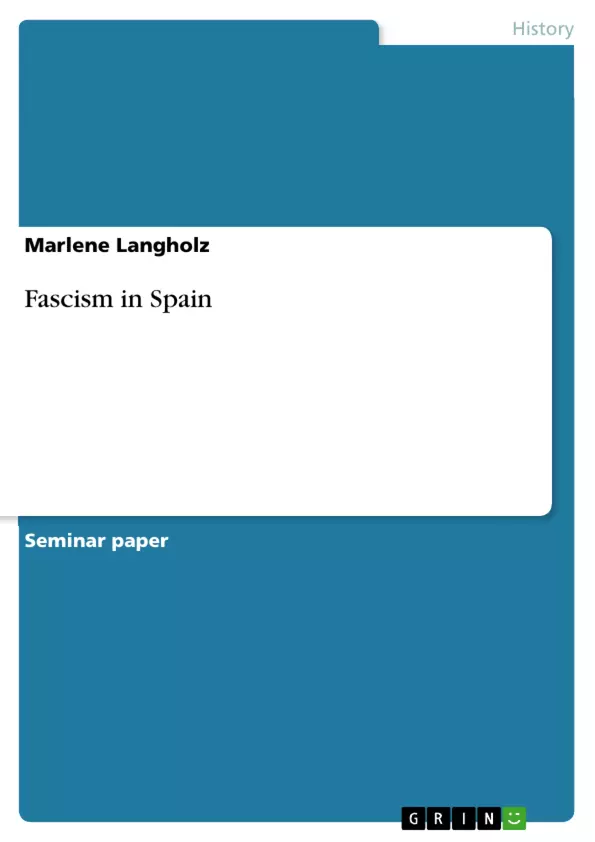The First Spanish Republic was founded in 1873. Its establishment began to launch tendencies in the Spanish concept of the state, which along with other causes, would later culminate in the Civil War of 1936. There were several reasons for the war, many of them long-term tensions that had escalated over the years. For the social and ideological arena, the years after 1931 were a continuous competition between a catholic-conservative right, a civic-liberal middle-class and an anarchic-secular left; at the international level, the Spanish fights were part of the general European contention of democracy, fascism and communism.
In this paper I would like to discuss the events that led to the establishment of the fascist regime of Francisco Franco that lasted from 1939 - 1975. Section 2 of the text will briefly summarize the political and social developments in Spain from 1923 to 1939 including the dictatorship of Primo de Riviera and
the Second Republic that followed and was governed by a coalition of the left and the center. In section three, I will focus on the Spanish Civil War and Franco`s rise to power, furthermore Franco`s dictatorship and resistance movements against the regime will be examined. Section four concludes.
Inhaltsverzeichnis (Table of Contents)
- Introduction
- Political and social developments in Spain from 1923-1939
- The Dictatorship of Primo de Riviera
- The Second Republic
- The Spanish Civil war and Franco`s rise to power
- The Franco Regime (1939-1975)
- Resistance against the regime
- Conclusion
Zielsetzung und Themenschwerpunkte (Objectives and Key Themes)
This paper examines the events leading to the establishment of Francisco Franco's fascist regime in Spain, which lasted from 1939 to 1975. It focuses on the political and social developments that contributed to the rise of fascism, including the dictatorship of Primo de Rivera and the Second Republic. The paper also explores the Spanish Civil War and its impact on Franco's rise to power, along with the nature of his dictatorship and the resistance it faced.
- The political and social landscape of Spain in the early 20th century.
- The influence of the dictatorship of Primo de Rivera and the Second Republic.
- The causes and consequences of the Spanish Civil War.
- The nature and impact of Franco's fascist regime.
- Resistance to the Franco regime.
Zusammenfassung der Kapitel (Chapter Summaries)
The introduction outlines the historical context of the Spanish Civil War, emphasizing the long-term tensions that culminated in the conflict. It highlights the paper's focus on the events leading to the establishment of Franco's regime and provides a brief overview of the paper's structure.
Chapter 2 delves into the political and social developments in Spain from 1923 to 1939, covering both the dictatorship of Primo de Rivera and the Second Republic. It examines the factors that contributed to the rise of these regimes and their impact on Spanish society.
Chapter 3 focuses on the Spanish Civil War and the rise of Franco to power. This chapter explores the key events of the war, the role of various political factions, and the impact of the war on Spanish society.
The chapter concludes by examining the nature of Franco's regime, including its policies and the resistance it encountered. It explores the complexities of the regime and its legacy for Spain.
Schlüsselwörter (Keywords)
The primary keywords and focus topics of this text include: Spanish Civil War, Francisco Franco, Primo de Rivera, fascism, dictatorship, Second Republic, resistance, political and social developments, ideology, nationalism, Catholic Church, and authoritarianism.
- Citar trabajo
- Marlene Langholz (Autor), 2008, Fascism in Spain, Múnich, GRIN Verlag, https://www.grin.com/document/154403



